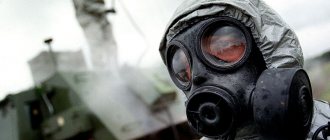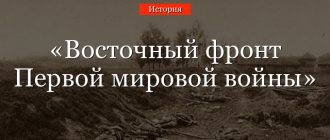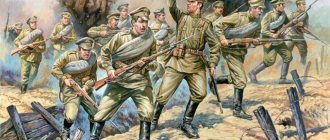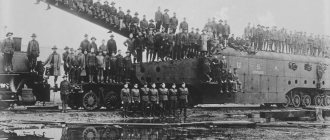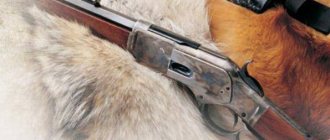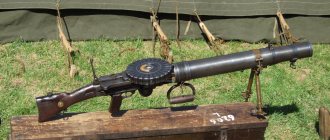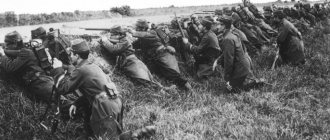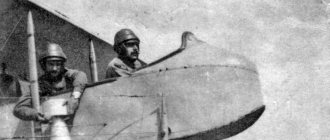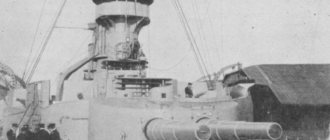Gas balloon attacks
In 1915, it all started with a simple idea that illuminated Germany.
Bring a lot of chlorine in cylinders (180 tons at Ypres) to the front, put it in the trenches and, after waiting for the right wind, release it on the enemy. Advantages: neither chlorine nor gas cylinders have any direct or indirect use in military affairs, and there are many of them available - you can take them and “mobilize” them for war without involving precious resources of the military industry.
Disadvantages: you need to wait for the weather. For a long time. They waited at Ypres for eleven days, and during the wait they suffered losses due to gas poisoning - the cylinders were damaged during artillery shelling.
And you need weather that doesn’t happen every day—too strong a wind will scatter the cloud, too weak a wind will leave it in place. Rain or fog is not allowed. Hot is also bad. And the direction of the wind should be towards the enemy. In addition, the cloud weakens with distance, and the gas eventually concentrates near its own trenches.
Gas attack on the Somme
But the first use at Ypres gave such an amazing result that the Germans did not even manage to use it. The African units fled in panic, but the reasonable actions of the Entente command, the justified mistrust of the Germans in their own gas masks and misunderstanding of the width of the breakthrough (it was estimated at three kilometers instead of eight) led to the fact that the overall effect did not work out.
Of the 15 thousand gassed, five thousand people died. The main reason for such losses was the mass panicked flight from the gas cloud - it was impossible to run faster than the wind...
The much more resilient Russian troops at Bolimov lost 9,038 gas poisoned, of which 1,183 died.
"Don't run from the gas"!
A breakthrough was not achieved.
stumbling ledge
Trying to achieve a decisive advantage, the warring parties also put chemists into their service. It is interesting that the first experiments in this direction were not aimed at killing at all - they wanted to use the irritating properties of gases to demoralize the enemy and weaken his will to resist.
But such tactics did not bring results, and the remnants of humanism left the German generals. The Hague Convention, adopted back in 1899, prohibited the use of ammunition whose sole purpose was to poison enemy personnel. However, in Germany they found a way out.
Ypres without mustard gas. The first use of poison gases was not the first Read more
The stumbling block for the warring parties was the Ypres salient - a territory in the area of the Belgian town of Ypres, where, according to the plans of the German command, a breakthrough of the enemy’s defensive lines was to be carried out. In reality, this territory turned into a zone of bloody positional battles that stretched from 1914 to 1918. With extremely little progress in one direction or another, the participants in the conflict lost tens and hundreds of thousands of people killed and wounded.
Phosgene
Chlorine is actually not a very poisonous gas. But phosgene, obtained back in 1811, is six times more poisonous. And most importantly, hyposulfite does not delay it.
In October 1915, a mixture of chlorine and phosgene at Fort Pompel (Champagne) was a notable success. However, 500 tons of the gas mixture released at the front over a distance of 17 kilometers caused very minor losses (1,515 poisoned and 253 dead on October 19; 2,581 poisoned and 562 dead on the 20th).
British trenches after gas attack
The danger and at the same time the problem of using phosgene is that it does not act immediately.
“Does it smell like rotten hay? This is not a reason to wear a gas mask!” - and half an hour later a mass of people were gassed.
But more time must pass from the gas release to the attack, and phosgene detected in time is a plus of half an hour for the defenders.
Past assaults and forces of the parties
The first two attempts to storm Osovets (A detailed history of the defense of Osovets is outlined in the book of a direct participant in the events S.A. Khmelkov “The Fight for Osovets.” - Ed.) were made in September 1914 and in February-March 1915 and ended in failure: the Germans suffered serious losses and did not resume the attack. The only thing is that the second attempt was more serious, and having failed, the Germans switched to positional warfare, actively accumulating forces and preparing a new assault.
The besiegers did not greatly outnumber the fortress garrison. However, German commanders were known for their ability to create a huge advantage in the main attack area, which they used on both the Eastern and Western fronts. This time, the 11th Landwehr (Landwehr - German militia-type troops, an analogue of the Russian militia - Ed.) division prepared for the assault extremely seriously. To capture the advanced Russian positions at Sosnenskaya and Zarechnaya, it was decided to use chemical agents and powerful artillery support.
Artillery attacks
By the end of 1916, gas attacks became obsolete. They were very dependent on the weather, and the main gas attack fell on the forward positions, and not on reserves and artillery. Yes, and I managed to defend myself from them better and better each time. I wanted something more - and it soon appeared.
German gas shell
In 1916, chemical shells (phosgene by the French and diphosgene by the Germans) were used rather as an experiment, but in 1917 the “gas rectangle” method was used for the first time. In the immediate enemy rear, chemical shells created rectangular-shaped contamination zones, primarily at artillery positions and reserve routes.
The main transport in the artillery remained the horse, and in a gas mask it can only survive, but not work - there is not enough air. So a battery filled with gas can neither move nor transport ammunition.
Also, the primary targets of chemical shells were command and observation posts, telephone exchanges and troop locations in the near rear. The German attack on Russian bridgeheads near the village of Toboly on April 3, 1917, undertaken using this method, was successful - all Russian batteries quickly fell silent, and up to ten thousand people were captured.
To “pierce” gas masks, the Germans were the first to introduce toxic fumes of arsenic compounds (arsine) - the protective equipment of that time did not protect against them. Non-lethal in themselves, they caused sneezing and coughing; The soldier struck by them, gasping for breath, took off his gas mask... and fell under the influence of phosgene.
Gas launchers
The desire to increase the useful volume of a projectile led to the appearance of Stokes mortars - the first mortars of the modern type. The effectiveness of their high-explosive fragmentation mines was assessed very quickly, but initially the main ammunition was supposed to be chemical. However, a mortar is almost real artillery (shorter range, thinner barrel), and the Livens gas launcher is a means of disposing of gas cylinders. No sight, no aiming mechanisms.
Soldiers loading Livens' gas launcher
Many pipes with a charge and a cylinder placed inside fire a salvo at the right moment, and a lot, a lot of gas ends up somewhere out there, in enemy positions. A lot - gas launcher attacks “pierced” gas masks with a local, very high concentration of gas.
Features of the use of chemical weapons
During the First World War, the parties developed the tactics of positional warfare, in which offensive operations became ineffective. As a way out of the stalemate, it was planned to use chemical weapons to break through the defense.
The military use of poisonous gases was a major innovation, and the range of toxic substances then was wide: from harmful (tear gas) to lethal (phosgene, chlorine, mustard gas). Although the lethal potential was limited to 4% of the total number of deaths affected, the mortality rate was quite high. Chemical weapons were the main danger for soldiers. Countermeasures developed over time against chemical attacks have reduced their effectiveness, and as a result, chemical weapons have fallen out of use. Since the massive use of toxic substances began in the First World War, it is sometimes called the “war of chemists.”
Are you an expert in this subject area? We invite you to become the author of the Directory Working Conditions
"Yellow Cross"
The Germans marked chemical shells with multi-colored crosses - green diphosgene, blue arsine, and in the “year of great chemistry”, in 1917, a fundamentally new substance appeared, marked with a yellow cross.
German gas shell for a 105 mm howitzer
Mustard gas.
First of all, he was persistent. An area contaminated with mustard gas remains dangerous for up to a day and a half in the open in the summer and up to a week in the winter. This allowed the creation of contaminated zones during retreat, but limited the use of mustard gas in the attack.
Secondly, he acted not only through the gas mask, but also through the skin.
Thirdly, this substance did not work immediately.
The debut of mustard gas was very effective - during the French offensive in August–September, they lost more than 13 thousand poisoned with mustard gas: 143 of them received a lethal dose, and the majority were out of action for two months. More important than the direct loss of life was the fact that the artillery was unable to accompany the advancing troops.
Soldiers exposed to mustard gas awaiting transport
Anti-mustard protection means - shoe covers and capes - appeared among the Allies only towards the end of the year.
Use of chlorine.
Every year, huge amounts of chlorine are produced worldwide – tens of millions of tons. Only in the USA by the end of the 20th century. About 12 million tons of chlorine were produced annually by electrolysis (10th place among chemical production). The bulk of it (up to 50%) is spent on the chlorination of organic compounds - to produce solvents, synthetic rubber, polyvinyl chloride and other plastics, chloroprene rubber, pesticides, medicines, and many other necessary and useful products. The rest is consumed for the synthesis of inorganic chlorides, in the pulp and paper industry for bleaching wood pulp, and for water purification. Chlorine is used in relatively small quantities in the metallurgical industry. With its help, very pure metals are obtained - titanium, tin, tantalum, niobium. By burning hydrogen in chlorine, hydrogen chloride is obtained, and from it hydrochloric acid is obtained. Chlorine is also used for the production of bleaching agents (hypochlorites, bleach) and water disinfection by chlorination.
Ilya Leenson
A promising dead end
Throughout 1918, combat chemicals competed in efficiency with conventional shells. The newest poison, lewisite, the “dew of death,” did not make it to the war, but for decades future battles were certainly seen as chemical ones.
Simple and reliable means of protection for each soldier and the increased pace of operations left these plans on paper. Which, however, did not stop even after World War II from improving chemical weapons, accumulating their reserves... and then taking a long and difficult time to destroy them.
What could be the role of combat chemistry today and tomorrow? Chemical weapons are unlikely to return to service in the foreseeable future. There are too many taboos, too many technical problems. The golden age of combat chemistry passed very quickly, and now its destiny is to be material for provocations.
Strong old man Haber
The first to propose the use of OM in the form of a gas cloud was the German professor Fritz Haber . Or Gaber, as we called him for a long time. A brilliant chemist, judging by the Nobel Prize he later received (for the synthesis of liquid ammonia from nitrogen and hydrogen), and a person with very specific moral properties. Haber was a German patriot and a Jew. “When there is no war,” he wrote, “I am a patriot of the whole world. When there is a war, I am a German patriot."
During the war, Haber led the chemical service of the German troops and developed techniques for using poison gases. After the war, his wife and son, unable to bear the dubious fame of being relatives of the “father of chemical weapons,” committed suicide. And Haber himself turned out to be a strong old man. When the Nazis, regardless of his past merits, expelled him from the post of director of the Berlin Institute of Physical Chemistry and Electrochemistry, which he had held since 1911, he emigrated. First to England, against whose soldiers he had recently used his infernal chemistry. Then to Switzerland, where he soon died.
Fritz Haber. Photo: Commons.wikimedia.org/German Federal Archives
